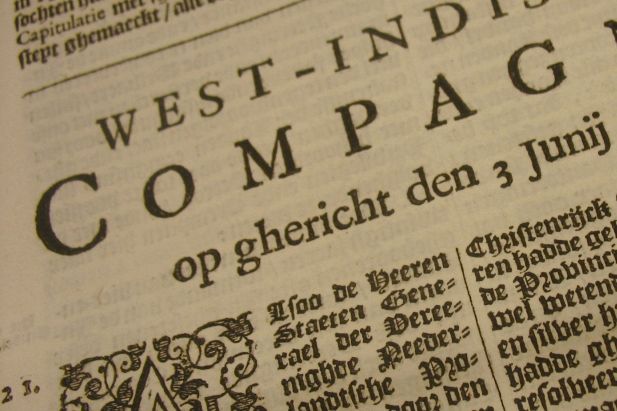The death of Oldenbarnevelt and the approaching end of the truce had given Usselincx a chance to press his plans for a West India Company. It was founded in 1621 and received a monopoly of trade with all countries west of the Cape of Good Hope and east of the Strait of Magellan, with untrammeled license to wage war on the enemy in his American colonies and prey on his ships in American waters.
The Dutch West India Company (WIC) was organized similarly to the Dutch East India Company (Dutch: Vereenigde Oost-Indische Compagnie, abbreviated as VOC), which had a trade monopoly for Asia (mainly present Indonesia) from 1602, except for the fact that the WIC was not allowed to conduct military operations without approval of the Dutch government.
The planting of colonies was another item on Usselincx's program. He was an ardent Calvinist, and war against Spain was to him identical with war against Rome. He hoped to strike a blow at the former's commercial interests in America and at the latter by spreading the Reformed religion through Protestant settlers. The founding of New Amsterdam on Manhattan in 1624 was, therefore, an act of war against both.
Dutch interest in Manhattan and the great river that flowed seaward past its western shore had been aroused by Henry Hudson's famous voyage in the Half Moon. His ship was owned by a group of Amsterdam merchants, and the ex- pedition he headed was one in a series of attempts to find a northeast passage through the arctic seas to China and the East Indies, beyond the reach of the enemy's patrolling men-of-war.
Previous attempts had ended in failure. The most famous of these was Willem Barents' third and last voyage. Its chief result was the discovery of the island that he chris- tened Spitsbergen. He did not live to bring the news to Amsterdam. For after wintering on Nova Zembla he left his icebound ship to her fate and set out with his crew in two open boats. Most of the party reached home, but Barents himself died and was given a grave in the arctic seas.
Hudson's search for the northeast passage was equally futile. Disobeying his employers' instructions to return if he failed in piloting the Half Moon through the ice, he sailed straight west in hope of reaching the Far East around the north of America. And thus he discovered the river that has since borne his name.
By September 1, 1623 a capital of more than seven million guilders had been invested in the West India Company, and in June, 1626, Peter Minuit made his famous purchase of Manhattan Island. By that time the town of New Amsterdam had been laid out, the fort was building, the colonists were settled. But through that purchase the accomplished fact of occupation acquired a semblance of justice which the Amsterdam directors were anxious to lend to their enterprise. For it was in obedience to their orders that Minuit paid the value of sixty florins to the Indians.
The settlement in North America was only a minor concern of the company. The Republic was at war with Spain and the company's first duty was to carry that war into the Spanish colonies. Its chief efforts, therefore, were directed against the West Indies and South America. In the thirties the company ousted the Spanish from Olinda and the Recife in Brazil, conquered St. Eustatius and Curasao, and wrested St. George del Mina, on the coast of West Africa, from the enemy.















